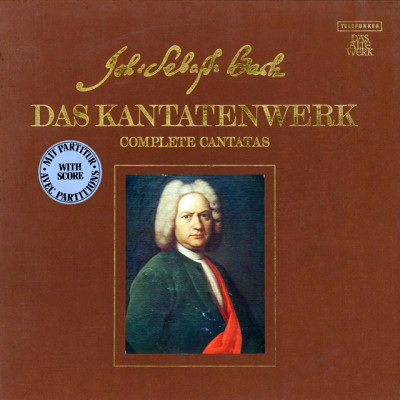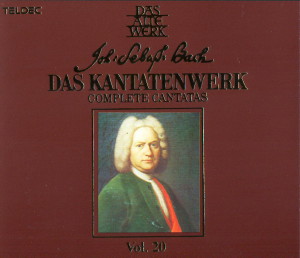 |
|
2 LPs
- SKW 20/1-2 - (p) 1978
|
 |
| 2 CDs -
8.35362 ZL - (c) 1989 |
|
| DAS KANTATENWERK - Volume 20 |
|
|
|
|
|
|
|
| Johann Sebastian
BACH (1685-1750) |
Kantate
"Du sollt Gott, deinen Herren, lieben",
BWV 77
|
|
15' 47" |
|
|
Kantate
am 13. Sonntag nach Trinitatis (Dominica
13 post Trinitatis)
|
|
|
|
|
Text:
Textdichter unbekannt; 1. Lukas 10,27; 6.
David Denicke 1657 (O Gottes Sohn, Herr
Jesu Christ)
|
|
|
|
|
Solo:
Sopran, Alt, Tenor, Baß - Chor; Tromba da
tirarsi (Zugtrompete); Oboe I, II;
streicher; B.c. (Violoncello, Violone,
Organo)
|
|
|
|
|
- 1.
Coro: "Du sollt Gott, deinen Herren,
lieben" |
4' 26" |
|
B1 |
|
- 2.
Recitativo (Basso): "So muß es sein" |
0' 34" |
|
B2 |
|
- 3.
Aria (Soprano): "Mein Gott, ich liebe dich
von Herzen" |
4' 12" |
|
B3 |
|
- 4.
Recitativo (Tenore): "Gib mir dabei, mein
Gott! ein Samariterherz" |
0' 55" |
|
B4 |
|
- 5.
Aria (Alto): "Ach, es bleibt in meiner
Liebe" |
4' 33" |
|
B5 |
|
- 6.
Choral: "Herr, durch den Glauben wohn in
mir" |
0' 53" |
|
B6 |
|
|
|
|
|
|
Kantate
"Gott, der Herr, ist Sonn und Schild",
BWV 79 |
|
15' 31" |
|
|
Kantate
am Reformationsfest (Festo
Reformationis) |
|
|
|
|
Text:
Textdichter unbekannt; 1. Psalm 84,12; 3.
Martin Rinckatt 1636; 6. Ludwig Helmbold
1575 |
|
|
|
|
Solo:
Sopran, Alt, Baß - Chor; Corno I, II
(Naturhörner in G), Timpani; Oboe I, II;
Streicher; B.c. (Violoncello, Violone,
Organo) |
|
|
|
|
- 1.
Coro: "Gott, der Herr, ist Sonn' und
Schild" |
4' 56" |
|
D1 |
|
- 2.
Aria (Alto): "Gott ist unsre Sonn' und
Schild" |
3' 39" |
|
D2 |
|
- 3.
Choral: "Nun danket alle Gott" |
2' 08" |
|
D3 |
|
- 4.
Recitativo (Basso): "Gottlob, wir wissen
den rechten Weg" |
0' 49" |
|
D4 |
|
- 5.
Aria - Duetto (Soprano, Basso): "Gott, ach
Gott, verlaß die deinen nimmermehr" |
3' 09" |
|
D5 |
|
- 6.
Choral: "Erhalt uns in der Wahrheit" |
0' 31" |
|
D6 |
|
|
|
|
|
Detlef
Bratschke (Solist des Knabenchor
Hannover), Sopran
Paul Esswood, Alt
Adalbert Kraus, Tenor (BWV 77)
Max van Egmond, Baß
Knabenchor Hannover |
Heinz Hennig, Leitung
Collegium Vocale Gent | Philippe
Herreweghe, Leitung
Das verstärkte LEONHARDT-CONSORT mit
Originalinstrumenten
- Don Smithers, Zugtrompete (Tromba da
tirasi)
- Adriaan van Woudenberg, Iman Soeteman,
Hörner
- Nick Woud, Pauken
- Ku Ebbinge, Bruce Haynes, Oboen
- Marie Leonhardt, Alda Stuurop, Janneke van
der Meer, Antoinette van den Hombergh, Keiko
Watanabe, Violinen
- Wiel Peeters, Ruth Hesseling, Violen
- Anner Bylsma, Dijck Koster (BWV 77,1,6;
79,1,3,5,6), Richte van der Meer (BWV 77,4),
Violoncelli
- Anthony Woodrow, Violone
- Gustav Leonhardt, Bob van Asperen (BWV
79,5), Orgel
Gustav Leonhardt, Gesamtleitung
|
|
|
|
|
Luogo
e data di registrazione |
|
Amsterdam (Holland) -
Maggio 1977
|
|
|
Registrazione: live
/ studio |
|
studio |
|
|
Producer |
|
Wolf Erichson
|
|
|
Prima Edizione LP |
|
Telefunken "Das Alte
Werk" | SKW 20/1-2 | 2 LPs -
durata 46' 35" - 36' 57" | (p)
1978 | ANA
|
|
|
Edizione CD |
|
Teldec Classics |
LC 6706 | 8.35362 ZL | 2 CDs -
durata 46' 35" - 36' 57" | (c)
1989 | ADD |
|
|
Cover
|
|
Johann Sebastian
Nach, einige Jahre vor seiner
Ernennung zum Kantor in Leipzig.
Gemälde con JJ. Ihle (1720) Bach
Museum Eisenach.
|
|
|
Note |
|
In questo volume sono
presenti anche La Cantate BWV 76 e
BWV 78 a cura del Concentus
Musicus Wien diretto da Nikolaus
Harnoncourt.
|
|
|
|
|
INTRODUCTION
by Ludwig Finscher
»Du sollt Gott, deinen
Herren, lieben« (BWV 77),
was written for the 13th
Sunday after Trinity (22nd
August) 1723, and thus is
also from Bach’s first
Leipzig annual cantata set.
In diametric opposition to
BWV 76, it is one of the
shortest and extremely
modest Bach cantatas. At the
same time, however, because
of its opening chorus it is
one of the extreme exemples
of the profound, theological
symbolic compositional
manner which so thoroughly
sets Bach apart from all his
composing contemporaries.
The quotation from the
Gospel according to St.
Luke, which forms the text
of the choir, is
compositionally set in
accordance with a parallel
passage from Matthew 22,
34-40, where the love of God
and of ones neighbours is
described as the foundation
»of all the law«. For this
reason the motet-like
imitative choral movement is
encompassed by a canon (=
law) of the outer voices,
trumpet and bass (=
allencompassing law) above
the chorale »Dies sind die
heil’gen zehn Gebot« (all
ten commandments are
included in the command to
love). In this connection,
the bass performs the melody
in enlarged note values ( =
the fundamental law) and the
trumpet has ten cues (= ten
commandments) and at the end
once more renders the entire
chorale, so that it appears
to be omnipresent. Finally
the motif of the singing
voices hints at the chorale,
clearly at least in the
first motif (retrograde
inversion of the first
chorale line). Perhaps the
most wonderful feature of
the movement, however, is
that the construction and
symbolism have superimposed
upon them a powerful, solemn
moving trait which
culminates in the subsequent
rendering of the entire
choral melody in the trumpet
above the tonic pedal point,
while the singing parts
intone the second half of
the text - »und deinen
Nächsten als dich selbst«.
Inevitably, compared with
this mighty piece of
theological musical text
exegesis, the other
movements of the cantata
fade somewhat; the unusual
simplicity of the two arias
and their individual tone -
as it were the answer of the
individual christian to the
choir’s promulgation of the
law - show that this
contrast was fully intended.
The soprano aria announces
the proximity of the loving
Christian to God,
emotionally in the gentle
suspended melody,
symbolically in the parallel
leading of the oboes. The
contralto aria is, despite
its da capo form, less an
aria than an intimate sacted
song with simultaneous
emotion-laden and almost
gallant, compass-point line
melody. In marked contrast
to this, as well as to the
muted tenor of the text, is
the use of the trumpet as
the solo instrument. The
concluding chorus, a
relatively simple cantata
movement, has come down to
us without text. Judging
from the contents of the
cantata and the line and
verse scheme given for the
choral melody (Ach Gott vom
Himmel sieh darein), it most
likely of all relates to
»Herrn, durch den Glauben
wohn in mir« from David
Denicke’s hymn »O Gottes
Sohn, Herr Jesu Christ«.
»Gott, der Herr, ist Sonn
und Schild« (BWV 79)
was probably written for
Reformation Day (31st
October) 1725. Similarly to
BWV 77 and 78 it is
concentrated almost entirely
on the opening chorus, but
from the point of view of
content is uninterruptedly
dominated by gratitude and
joy, and accordingly is an
extrovert work. This is
already apparent from the
orchestral scoring, with
horns and kettledrums,
oboes, strings and continuo,
to which flutes were added
in subsequent performances.
Already in the orchestral
prelude the chorus develops
all the splendour
appropriate for this
particular day: a festive
horn theme, then a lively
fugato, and then both themes
combined. The first choral
sections are accompanied by
the fugal theme and
punctuated by the horn
theme, and then a choral
fugue develops from the
instrumental fugal theme.
Finally the first choral
section, freely repeated, is
built into a repetition of
the beginning and conclusion
of the instrumental
introduction. The contralto
aria which follows turns the
jubilating note into the
intimate and individual
aspect, although the text
continues to speak of the
congregation. The chorale
once again takes up the horn
theme of the first chorus
and thus rounds off the
three first parts of the
work into a unit. Perhaps
originally the sermon
followed at this point. The
movements which then follow
are at any rate lightweight
compared with the powerful
first section of the
cantata, and are of a
markedly simple
construction. In the
concluding chorus horns and
kettledrums once more
establish a relationship
with the festive splendour
of the first half of the
cantata, as accords with the
text of the chorale.
|
  |
|
|